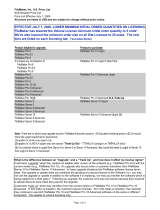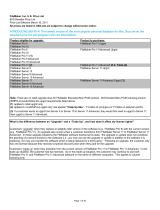
Chapter 1 | Introducing FileMaker WebDirect 9
FileMaker Server responds to requests from the web browser as follows:
1. The Database Server sends layout information and data from a hosted solution to the WPE.
2. The WPE translates layouts and data from the solution into HTML5, CSS3, and JavaScript code
and data for the browser.
3. The web server sends the translated layouts and data from the WPE to the browser.
In the web browser, FileMaker WebDirect renders the HTML5, CSS3, and JavaScript code
generated by the WPE, captures user clicks and key presses, and sends these interactions to the
Database Server to be processed.
Implicit interaction model
To enable your solution to behave more like an application, FileMaker WebDirect implements an
implicit interaction model. In FileMaker
Pro and FileMaker Go, users are accustomed to
committing changes in fields, clicking buttons to show custom dialog boxes, seeing data as it is
being updated by other users, and seeing conditional formatting change as conditions change, all
without explicitly submitting their changes or refreshing the display. FileMaker
WebDirect brings
that same level of implicit interaction to users on the web.
HTTP connections between a web browser and server start when the browser sends a request to
the server; the server then sends back data in response. To enable FileMaker
Server to push data
to the browser when the browser hasn’t requested anything, FileMaker
WebDirect employs a
technique called long polling. When the web browser initiates a FileMaker
WebDirect connection,
the browser sends an HTTP request to the server and tells the server to hold this request until the
server has something to send. When the server has an update to send (data or user interface
updates), the server uses this outstanding request to respond. The web browser processes the
response, then sends another request to the server, which the server holds again until it has
something to send. In this way, the web browser always keeps a request outstanding with the
server, which responds as needed.
How FileMaker WebDirect renders a layout
For every object on a layout, the WPE generates a unique ID. When a web user interacts with an
object, the browser detects the interaction and sends the object ID and interaction to the WPE and
then to the Database Server, which controls the entire operation. The Database Server processes
the interaction and sends a response; the WPE converts the response to HTML5, CSS3, and
JavaScript code and then sends it to the browser.
For example, you’ve designed a FileMaker WebDirect solution that has one layout containing a
button that’s set up to run the Show Custom Dialog Box script step. To access the solution, a web
user types the URL in a browser or clicks a link. The request to open the solution comes to the
web server, which passes the request to the WPE. The WPE tells the Database Server to open
the specified database. The WPE authenticates the user with the Database Server, opens a
session, and performs other startup activities. If the user is allowed to open the database, the
Database Server passes information about the layout and button to the WPE. In real time, the
WPE generates the code to represent the layout and the button, including the formatting
information for the button’s pressed and hover states and a unique ID for the button. When the
user clicks the button on the layout, the browser sends the click along with the button’s ID to the
WPE. The WPE tells the Database Server that the button was clicked; the Database Server runs
the script step, responds that the script ran successfully, and tells the WPE to display the custom
dialog box. The WPE generates the code for the custom dialog box and then sends it to the web
browser to display.























